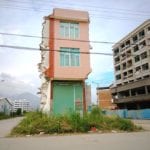 History
History  History
History  Creepy
Creepy 10 More Representations of Death from Myth, Legend, and Folktale
 Technology
Technology 10 Scientific Breakthroughs of 2025 That’ll Change Everything
 Our World
Our World 10 Ways Icelandic Culture Makes Other Countries Look Boring
 Misconceptions
Misconceptions 10 Common Misconceptions About the Victorian Era
 Mysteries
Mysteries 10 Strange Unexplained Mysteries of 2025
 Miscellaneous
Miscellaneous 10 of History’s Most Bell-Ringing Finishing Moves
 History
History 10 Great Escapes That Ended Right Back in Captivity
 Weird Stuff
Weird Stuff 10 Fascinating Things You Might Not Know About Spiders
 Food
Food 10 Everyday Foods You Didn’t Know Were Invented by the U.S. Military
 History
History 10 Most Influential Protests in Modern History
 Creepy
Creepy 10 More Representations of Death from Myth, Legend, and Folktale
 Technology
Technology 10 Scientific Breakthroughs of 2025 That’ll Change Everything
Who's Behind Listverse?

Jamie Frater
Head Editor
Jamie founded Listverse due to an insatiable desire to share fascinating, obscure, and bizarre facts. He has been a guest speaker on numerous national radio and television stations and is a five time published author.
More About Us Our World
Our World 10 Ways Icelandic Culture Makes Other Countries Look Boring
 Misconceptions
Misconceptions 10 Common Misconceptions About the Victorian Era
 Mysteries
Mysteries 10 Strange Unexplained Mysteries of 2025
 Miscellaneous
Miscellaneous 10 of History’s Most Bell-Ringing Finishing Moves
 History
History 10 Great Escapes That Ended Right Back in Captivity
 Weird Stuff
Weird Stuff 10 Fascinating Things You Might Not Know About Spiders
 Food
Food 10 Everyday Foods You Didn’t Know Were Invented by the U.S. Military
10 Tragedies Due To Construction-Related Faults
When it comes to the construction industry, there is absolutely no room for error. People’s lives and livelihoods depend on it. All it takes to cause a disaster is one seemingly unimportant mistake caused by human error, corruption, or environmental conditions that weren’t originally considered. Many people die no matter the root cause. The one thing that leaves a bitter aftertaste is the fact that it could have been prevented.
Whether it was a building or a bridge crumbling to pieces due to construction methods and materials, unregulated safety standards, or the environment testing the structure to its limits, there is a lesson to learn in each and every tragedy. Here are ten of the most horrible tragedies to ever happen due to construction-related mistakes.
10 Pleasants Power Station
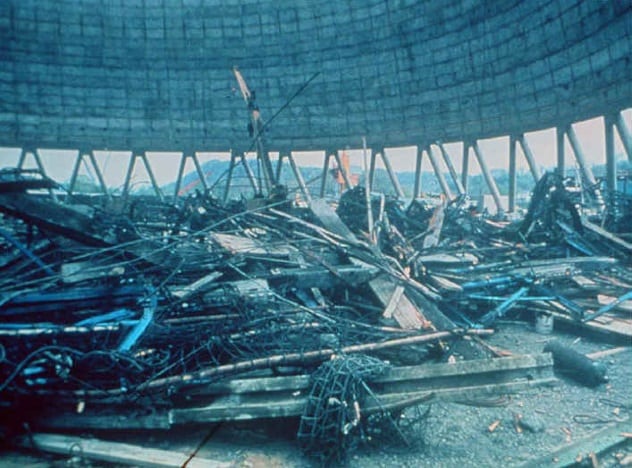
Early in 1978, construction was underway for a second cooling tower for West Virginia’s Pleasants Power Station. On April 27, most of the construction workers were busy with their duties on the scaffolding inside the hyperbolic-shaped structure when the concrete started to peel away at the 28th lift (the previous day’s concrete). The scaffolding gave way, which led to all of the construction workers on falling to their deaths and some of them being buried by the falling debris. Fifty-one workers tragically lost their lives.[1] The event would come to be referred to as the Willow Island disaster.
Witnesses said that it sounded like a train derailing. The only survivors were seven workers who were busy doing ground-level tasks. Ever since the accident, workers have suspected that the scaffolding’s concrete was still wet, which led to the tragedy. At the time, nobody could figure out the official cause of the accident because of the fact that there was nothing different about the way the roughly 50-meter (165 ft) tower was constructed than similar towers. Yet, officials were skeptical about the strength of the concrete that was used. One rescue worker said that the concrete “crumbled in his hands.” David H. Rhone, head of the accident investigation for the Occupational Safety and Health Administration (OSHA), said that it could have been a combination of stress, mechanical failure, and, of course, the strength of the concrete.
9 Fatal Tower Crane Collapse
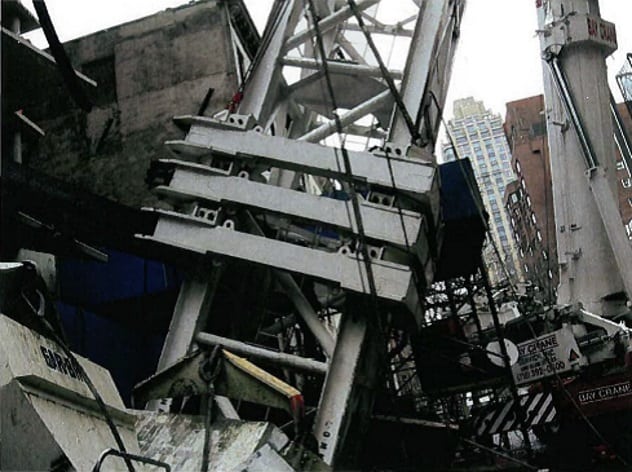
On March 15, 2008, during the construction of a 43-story concrete-framed condo on 303 East 51st street in Manhattan, a tower crane which was approximately 76 meters (250 ft) high collapsed. Six construction workers were killed, as was a civilian who lived in a nearby apartment when a part of the crane came crashing through. The construction workers were busy placing lateral tie beams on the 18th floor of the building to provide the crane with some support. About an hour earlier, the crane was “jumped,” which means that four additional sections were added to the lower mast.
The construction workers were installing the tie beams without the use of a mobile crane, which was the very first time they used that method. The 19th floor was already poured, with the preparations in place to make the 20th floor. Further investigations concluded that the choice to use polyester slings was a questionable decision, the collar was rigged improperly, and that the slings were not protected against sharp edges. They also used a deteriorated sling, which was supposed to have been thrown away instead of used again.[2]
8 Hawk’s Nest Tunnel Disaster
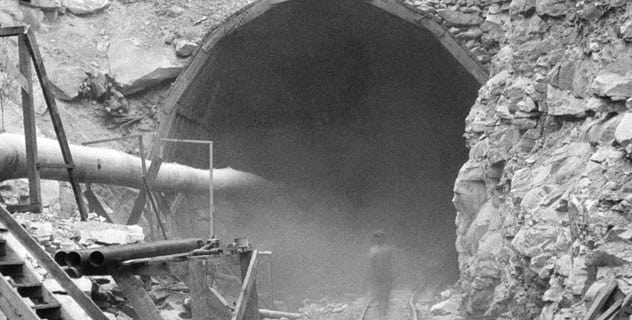
One of the worst (and most unconventional) construction disasters ever happened in the early 1930s, during the building of a 5-kilometer (3 mi) tunnel through Gauley Mountain between Ansted and Gauley Bridge in West Virginia. This tunnel would be used to divert water from the New River to a hydroelectric plant downstream. Hundreds of unemployed men were recruited for the construction, two thirds of whom were African Americans. After drilling a tunnel about 10 meters (33 ft) into the mountain, the workers came across rock that contained high levels of silica. Since they were dry-drilling, it released large amounts of dust into the air, which made working in the tunnel extremely dangerous.
Because of the fact that the Hawk’s Nest Tunnel was licensed as a civil engineering project, the most basic forms of safety were not applied. This led to men working in confined spaces, with limited use of breathing protection and a lack of dust control. Over the course of a few months, workers began falling ill with symptoms of silicosis, yet they were treated for a new disease called “tunnelitis.” Of the approximate 5,000 workers who labored on the project, over 2,900 worked inside the tunnel. At least 764 of these people lost their lives due to silicosis, an ailment caused by the inhalation of silica dust, which can lead to eventual death.[3]
7 Deepwater Horizon Oil Rig Explosion
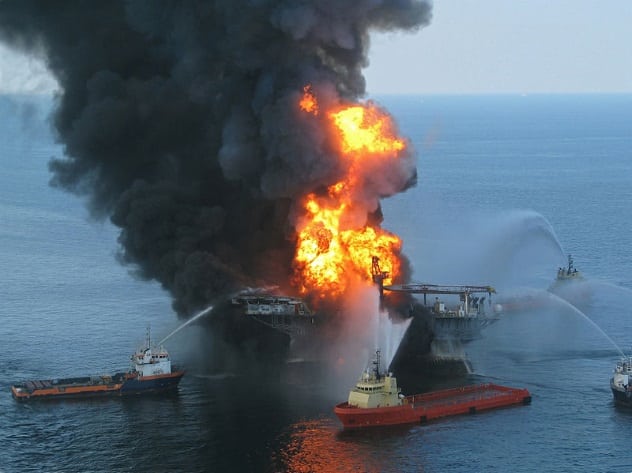
In 2010, one of the worst marine oil spills happened at the Gulf of Mexico on Deepwater Horizon, a BP-operated oil rig on the Macondo Oil Prospect near the Mississippi River Delta in the US. One night, a surge of natural gas erupted through a concrete core that was installed in order to seal the well for later use. The natural gas traveled up to the platform, where it ignited. Eleven workers were killed and 17 were injured before the rig capsized and sank. A similar incident had happened on another BP-owned oil rig in the Caspian Sea. Both of the cores used were most likely too weak to withstand the pressure due to the fact that the concrete mixture contained nitrogen gas to accelerate curing.[4]
The rig’s blowout preventer (BOP), a fail-safe mechanism to close the channel through which the oil was being drawn, malfunctioned. US government officials estimated that the daily spill of oil exceeded 60,000 barrels at its worst. Despite various clean-up efforts, the damage was already done. The spill affected many of the surrounding industries and left as many as 12,000 people temporarily unemployed. A vast amount of harm was done to the wildlife in and around the Gulf of Mexico, causing the deaths of over 800,000 birds and 65,000 turtles. It is also estimated that 20 percent of the oil spilled may have sunk to the bottom of the ocean, damaging deep-sea ecosystems.
6 Mecca Crane Collapse
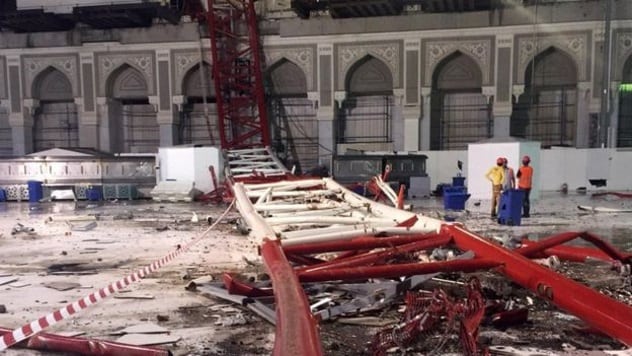
In Saudi Arabia, a large red and white crane came crashing down into the Grand Mosque (the biggest mosque in the world) in Mecca, which was filled with worshipers at the time. The incident took place on September 11, 2015, and 111 people lost their lives. Nearly 400 other people inside the mosque at the time sustained nonfatal injuries. Images and videos of the bloody aftermath made the rounds on social media.
The head of Saudi Arabia’s civil defense concluded that strong winds and heavy rains were to blame. Shortly before the devastating crash, the city had been hit with an unusual amount of rainfall and winds reaching up to 80 kilometers per hour (50 mph). Further investigations were conducted to reassess the safety standards of the construction site.[5]
5 The Savar Building Collapse
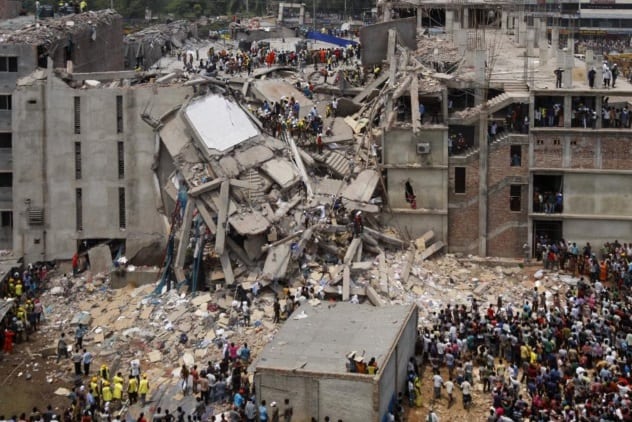
A five-story commercial building in the Dhaka District of Bangladesh called the Rana Plaza collapsed, killing 1,134 people. The incident happened during the morning rush hour on April 24, 2013. Rescue efforts continued up until May 13, during which approximately 2,500 people were saved from the debris.
A thorough investigation revealed that the mayor and owners of the building wrongfully granted construction permits to have additional floors constructed. Substandard building materials were used, and building code violations were ignored during the construction of the new floors. For the building to remain efficient, the owners had to install large generators on the upper floors for the factory to be able to keep producing during blackouts. This enormous amount of weight added strain to the poorly built upper levels. According to reports, the building would shake every time the generators were turned on.
A day before the incident, cracks began to form in the foundations and walls. An engineer was called in to inspect it and declared it unsafe, yet the owners demanded that their work continue despite the unsafe conditions. The very next day, tragedy struck.[6]
4 Rio De Janeiro Building Collapse
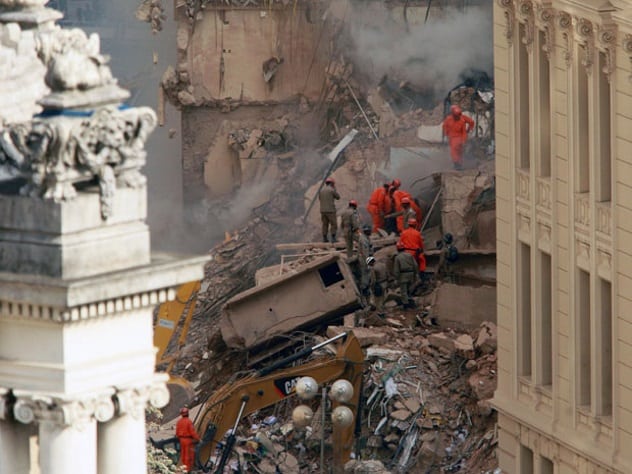
On January 25, 2012, three buildings close to the Municipal Theatre and the headquarters of oil giant Petrobras in Rio de Janeiro collapsed, leaving 17 people dead. Dozens of emergency workers flocked to the scene to assist in rescue efforts, but it soon became clear that it would be unlikely they’d find anyone alive underneath the debris. Many of the residents saw their entire livelihoods crumble before their eyes. A building inspector from Rio de Janeiro’s Regional Council of Engineering told a television network that he feared that there were illegal construction projects taking place in one of the buildings, which could have been a contributing factor to the tragedy.
A witness who saw the event unfold said that he was not surprised to see the buildings topple, stating that the infrastructure in those areas was unregulated and ignored by safety officials. According to Professor Paulo Roberto do Lago Helene from the civil engineering school of the University of Sao Paulo, Brazil still lacked legislation ordering owners of buildings to periodically examine the condition of their structures at that point of time.[7]
3 Apartment Building in China Collapses
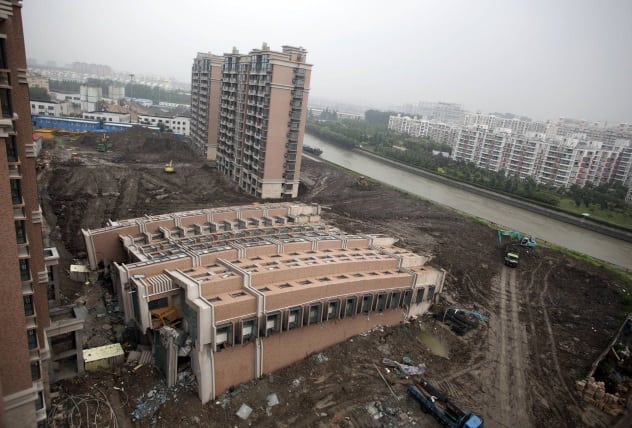
A nearly completed 13-story apartment building in Shanghai, China, collapsed unexpectedly on June 27, 2009, prompting building safety concerns. The building was part of the Lotus Riverside apartment complex, and one worker lost his life in the incident. Nine employees of the company developing the complex were placed in police custody for questioning. Suspicions that the building was shoddily constructed were dismissed temporarily because of the fact that the structure toppled over in one piece.
The sight of the building on its side quickly became a tourist attraction. Further investigations found that the license of the company developing the apartment building, Shanghai Meidu Real Estate Co., expired in 2004. Their funds were frozen for the rest of the investigation. A former construction technician said that corruption in the building industry of China is endemic, with developers bribing department officials with luxuries to get them to sign off on the necessary documentation to begin construction.[8]
2 Kolkata Bridge Collapse
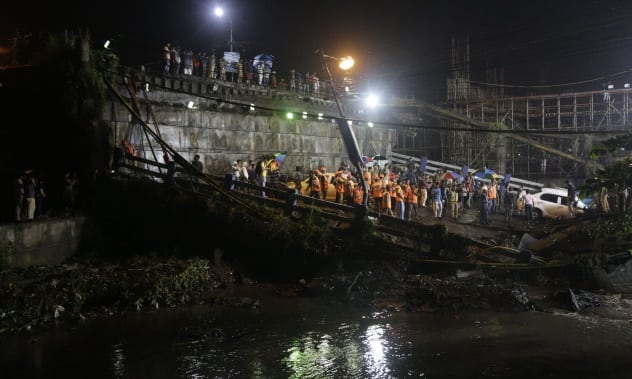
In the Indian city of Kolkata, a bridge collapsed and killed three people while injuring 25. It was the Majerhat bridge in South Kolkata, and it collapsed at around 4:40 PM on September 4, 2018, sending ten vehicles crashing into the rubble below. Some construction workers from nearby helped to rescue at least five people.
Mamata Banerjee, the West Bengal state chief minister, mentioned that questions were already being asked about the maintenance of the 40-year-old bridge. Another, more disastrous bridge collapse happened in 2016, when a part of a bridge that was under construction in the Burrabazar area of Kolkata toppled, killing 26 people and injuring 90. In that event, eight engineers were arrested for negligence. The West Bengal state governor, Keshari Nath Tripathi, said that the Majerhat bridge deserved better maintenance. He also mentioned that there had been a pit on the bridge for quite a period of time, and he was unsure if it was noted by the public works department.[9]
1 Florida International University Pedestrian Bridge Collapses
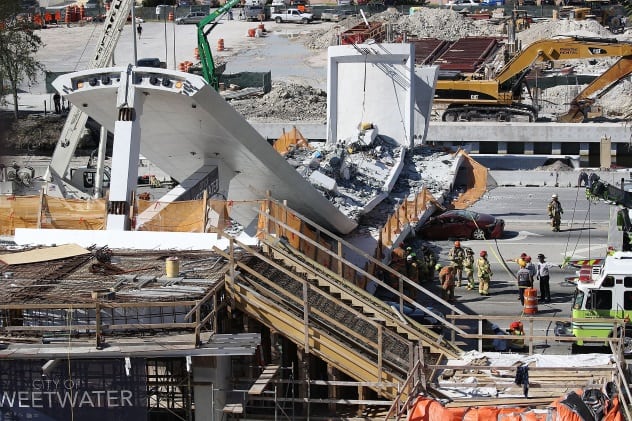
On March 15, 2018, a newly built pedestrian bridge which was installed to give walkers access to the FIU campus from the dorms and off-campus housing collapsed onto Southwest Eighth Street. Six people were killed, and several others sustained injuries. At the time, it wasn’t clear what caused the $14.2 million bridge to collapse. It was originally scheduled to open in 2019, but because of the “innovative” method of installation that had workers moving the walkway into place before the main support tower could be installed, it entered use much earlier than expected. This was obviously a risky decision.
Two workers were on the bridge when it collapsed, and they were busy conducting a stress test on the technically unfinished bridge, tightening the steel cables that ran through the bridge slab sections. Experts said that overtightened steel cables could have caused the structure to “camber,” or buckle, much like what witnesses described seeing before the collapse. Apart from the bridge being unusually heavy, an engineer left a note two days before the tragedy, warning of the cracks that had started to form in the bridge at one end. Sadly, the message was received too late. Yet, no evidence was found at the time suggesting that the cracks were a contributing factor.[10]
You can follow me on Twitter @JustThatChickXD.
Read about more disasters of man’s own making on 10 Truly Devastating Disasters Caused By Sleep Deprivation and 10 Disasters That Sparked New Safety Regulations.

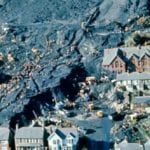
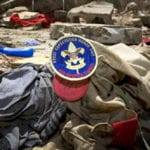

![Top 10 Haunting Images Of Historic Tragedies [DISTURBING] Top 10 Haunting Images Of Historic Tragedies [DISTURBING]](https://listverse.com/wp-content/uploads/2020/05/33758v-150x150.jpg)


